Bibliometric Mapping of Research on Magic Towns of Mexico
Abstract
1. Introduction
2. Magic Towns of Mexico
3. Methodology
4. Results and Discussion
4.1. Documents/Productivity
Overlap in Databases
4.2. Citations
4.3. Authors
4.4. Mapping of “Pueblos Mágicos de México” Research with VOS Viewer Software
4.5. Productivity by Country and Institution
4.6. Journals
4.7. Research Areas
4.8. Keywords
4.9. Lines of Research
5. Conclusions
- (1)
- The most productive educational institution is the University of Guadalajara, Mexico, with ten affiliations by ten different authors.
- (2)
- The journal that has received the most papers is PASOS indexed in the WoS Emerging Source Citation Index and the journals “Investigaciones Geográficas” and “Investigaciónes Turísticas”, which are both indexed in Scopus and particularly the latter also in Emerging Source Citation Index of WoS.
- (3)
- In both databases, the Social Sciences research area stood out as the area with the highest number of articles indexed in both WoS and Scopus.
- (4)
- Finally, in the keyword analysis, the word “tourism” appears most frequently in WoS, with 14 repetitions. In Scopus the term “cultural tourism” stands out, with four repetitions, although “tourism” also appears in the same position.
- (5)
- Furthermore, in the analysis of coverage and overlap between both databases, an overlap between both databases of 21.15% is observed (11 articles are indexed in both databases) and a degree of singularity of 76.09% in WoS, which indicates that this database provides a better coverage of the research in the context of Magic Towns of Mexico.
Author Contributions
Funding
Institutional Review Board Statement
Informed Consent Statement
Data Availability Statement
Conflicts of Interest
References
- Juárez, A.B. Dynamic conceptual model of local tourism: A case of study of a magical town in Hidalgo, Mexico/Dynamic conceptual model of local tourism: A case of study of a magical town in Hidalgo, Mexico. Utop. Prax. Latinoam. 2020, 25, 275–284. [Google Scholar]
- World Tourism Organization (UNWTO). Panorama OMT Del Turismo Internacional. 2017. Available online: https://www.e-unwto.org/doi/pdf/10.18111/9789284419043 (accessed on 4 July 2021).
- Shaadi Rodríguez, R.M.A.; del Socorro Shaadi Rodríguez, L.; Pulido-Fernández, J.I.; Rodríguez Herrera, I.M. Magic peoples programme—Its localities in phase of involvement. Anatolia 2018, 30, 189–199. [Google Scholar] [CrossRef]
- López, L. Las territorialidades del turismo: El caso de los Pueblos Mágicos en México. Atelie Geogr. 2018, 12, 6–24. [Google Scholar] [CrossRef]
- Nuñez, G.; Ettinger, C. La transformación de un territorio cultural. El desarrollo de los pueblos mágicos en México: Pátzcuaro como caso de estudio. Rev. Urbano 2020, 41, 40–57. [Google Scholar] [CrossRef]
- SECTUR. Reglas de Operación Pueblos Mágicos. 2001. Available online: http://www.sectur.gob.mx/wp-content/uploads/2018/10/Memoria-Documental-Pueblos-M%E2%80%A0gicos-Incorporaci%C2%A2n-y-Permanenecia.pdf (accessed on 4 July 2021).
- Shaadi Rodríguez, R.M.; Pulido Fernández, J.I.; Rodríguez Herrera, I.M. La consolidación turística en los territorios que conforman el Programa Pueblos Mágicos (México). Un análisis de sus estrategias competitivas. Investig. Tur. 2018, 15, 1–33. [Google Scholar] [CrossRef]
- Lemus, J. Pueblos Mágicos, Modelo de Exportación. 2017. Available online: https://www.reporteindigo.com/reporte/turismo-promocion-modelo-pueblos-magicos-regiones-america-latina/ (accessed on 4 July 2021).
- De La Rosa, A. Replicarán Programa De Pueblos Mágicos En El Extranjero. El Economista. 2012. Available online: https://www.eleconomista.com.mx/empresas/Replicaran-programa-de-Pueblos-Magicos-en-el-extranjero--20120916-0056.html (accessed on 4 July 2021).
- Escribano, M. Pueblos Mágicos De España: Seis Paraísos Aquí Al Lado. 2021. Available online: https://viajar.elperiodico.com/destinos/pueblos-magicos-espana-seis-paraisos (accessed on 4 July 2021).
- Moed, H.F. Citation Analysis in Research Evaluation; Springer: Dordrecht, Germany, 2005. [Google Scholar]
- Merton, R.K. The sociology of science: An episodic memoir. In Sociology of Science in Europe; Merton, R.K., Gaston, J., Eds.; Sourthern Illinois University Press: Carbondale, IL, USA, 1977; pp. 3–141. [Google Scholar]
- SECTUR. Pueblos Mágicos. Reglas de Operación. México: Secretaría de Turismo. 2001. Available online: http://www.sectur.gob.mx/wp-content/uploads/2014/10/GUIA-FINAL.pdf (accessed on 4 July 2021).
- Broadus, R.N. Toward a definition of bibliometrics. Scientometrics 1987, 12, 373–379. [Google Scholar] [CrossRef]
- Benavides, C.A.; Guzmán, V.F.; Quintana, C. Evolución de la literatura sobre empresa familiar como disciplina científica. Cuad. Econ. Dir. Empresa 2011, 14, 78–90. [Google Scholar] [CrossRef]
- Nicholas, D.; Ritchie, M. Literature and Bibliometrics; Clive Bingler: London, UK, 1978. [Google Scholar]
- Cancino, C.A.; Merigó, J.M.; Torres, J.P.; Diaz, D. A bibliometric analysis of venture capital research. J. Econ. Financ. Adm. Sci. 2018, 23, 182–195. [Google Scholar] [CrossRef]
- Valenzuela-Fernández, L.; Merigó, J.M.; Nicolas, C. The most influential countries in market orientation: A bibliometric analysis between 1990 and 2016. Int. J. Eng. Bus. Manag. 2018, 10. [Google Scholar] [CrossRef]
- Jiménez, F.; Muñoz, A.I.; Charneca, C.S. Modelo de turismo humano para el bienestar de Tapijulapa Pueblo Mágico, Tabasco, México. PASOS Rev. Tur. Patrim. Cult. 2018, 16, 685–700. [Google Scholar] [CrossRef]
- Fernández, A.M. Turismo, negocio o desarrollo: El caso de Huasca, México. PASOS Rev. Tur. Patrim. Cult. 2018, 16, 233–251. [Google Scholar] [CrossRef][Green Version]
- García, D.; Guerrero, H. El programa Pueblos Mágicos: Análisis de los resultados de una consulta local ciudadana. El caso de Cuitzeo, Michoacán, México. Econ. Soc. 2018, 18, 71–94. [Google Scholar]
- Alvarado-Sizzo, I. Territorial dynamics of cultural tourism in Izamal, Yucatan, Mexico. Geojournal 2015, 81, 751–770. [Google Scholar] [CrossRef]
- Hernández, J. Tequila: Centro mágico, pueblo tradicional. ¿Patrimonialización o privatización? Andamios 2009, 6, 41–47. [Google Scholar] [CrossRef]
- Clausen, H.; Velázquez, M. La posición social y espacial en una ciudad turística. Las luchas simbólicas de Álamos, Sonora. PASOS Rev. Tur. Patrim. Cult. 2010, 8, 47–59. [Google Scholar]
- Valverde, M. La magia de los pueblos ¿atributo o designación? Topofilia 2013, 4, 1–24. [Google Scholar]
- López, L. Huamantla de la ciudad heroica al pueblo mágico. Topofilia 2013, 4, 1–18. [Google Scholar]
- Rodríguez, I. Desafío y dilema en la política pública del pueblo mágico mexicano. Topofilia 2013, 4, 1–25. [Google Scholar]
- Méndez, E. Narrar los pueblos imaginarios del turismo: Una narrativa del patrimonio cultural. Arquit. Ciudad Reg. 2014, 1, 11–22. [Google Scholar]
- OECD. Tourism Trends and Policies. 2012. Available online: https://www.oecd-ilibrary.org/industry-and-services/oecd-tourism-trends-and-policies-2012_tour-2012-en (accessed on 4 July 2021).
- Moher, D.; Liberati, A.; Tetzlaff, J.; Altman, D.G.; The PRISMA Group. Preferred reporting items for systematic reviews and meta-analyses: The PRISMA statement. BMJ 2009, 339, b2535. [Google Scholar] [CrossRef]
- Herrera-Franco, G.; Montalván-Burbano, N.; Carrión-Mero, P.; Bravo-Montero, L. Worldwide Research on Socio-Hydrology: A Bibliometric Analysis. Water 2021, 13, 1283. [Google Scholar] [CrossRef]
- Callón, M.; Curtial, J.P.; Penan, H. Cienciometría; Ediciones Trea: Gijón, Spain, 1995. [Google Scholar]
- Alberca, F.A. Sobre los estudios bibliométricos en turismo. Cultura 2020, 34, 125–143. [Google Scholar]
- Durán-Sánchez, A.; Del Río-Rama, M.C.; Álvarez-García, J. Bibliometric analysis of publications on wine tourism in the databases Scopus and WoS. Eur. Res. Manag. Bus. Econ. 2017, 23, 8–15. [Google Scholar] [CrossRef]
- Pulgarín, A.; Escalona, M.A. Medida del solapamiento en tres bases de datos con información sobre ingeniería. An. Doc. 2007, 10, 335–344. [Google Scholar]
- Costas, R.; Moreno, L.; Bordons, M. Solapamiento y singularidad de MED-LINE, WoS e IME para el análisis de la actividad científica en una región de Ciencias de la Salud. Rev. Esp. Doc. Cient. 2008, 31, 327–343. [Google Scholar]
- Gluck, M. A review of journal coverage overlap with an extension to the definition of overlap. J. Am. Soc. Inf. Sci. 1990, 41, 43–60. [Google Scholar] [CrossRef]
- Bearman, T.C.; Kunberger, W.A. A Study of Coverage Overlap among Fourteen Major Science and Technology Abstracting and Indexing Services; National Federations of Abstracting and Indexing Services: Philadelphia, PA, USA, 1977. [Google Scholar]
- Durán-Sánchez, A.; Álvarez-García, J.; González-Vázquez, E.; Del Río-Rama, M.C. Wastewater Management: Bibliometric Analysis of Scientific Literature. Water 2020, 20, 2963. [Google Scholar] [CrossRef]
- Clausen, B.H.; Gyimóthy, S. Seizing community participation in sustainable development: Pueblos Mágicos of Mexico. J. Clean. Prod. 2016, 111, 318–326. [Google Scholar] [CrossRef]
- Coronado, Y.; Rosas, M.; Cerón, H. Ecotourism as a path to sustainable development in an isolated Magic Town. J. Tour. Anal. Rev. Anál. Tur. 2018, 25, 23–38. [Google Scholar]
- Saiz-Álvarez, J.M. Sustainable tourism and social entrepreneurship. The magic town of Tequila, Mexico. RETOS Rev. Cienc. Adm. Econ. 2018, 8, 51–67. [Google Scholar]
- Durán-Díaz, P.; Armenta-Ramírez, A.; Kurjenoja, A.K.; Schumacher, M. Community Development through the Empowerment of Indigenous Women in Cuetzalan Del Progreso, Mexico. Land 2020, 9, 163. [Google Scholar] [CrossRef]
- Vizcaino-Suárez, L.P.; Serrano-Barquín, R.; Cruz-Jiménez, G.; Pastor-Alfonso, M.J. Turismo, alfarería y trabajo femenino en el Pueblo Mágico de Metepec, México/Tourism, pottery and women’s work in the Magical Town of Metepec, Mexico. PASOS Rev. Tur. Patrim. Cult. 2017, 15, 391–407. [Google Scholar]
- De la Rosa, B.; Cruz, G.; Castillo, M. Policy networks, elites and governance. A conceptual framework for a case study in tourism. PASOS Rev. Tur. Patrim. Cult. 2017, 14, 595–609. [Google Scholar]
- Gross, T. Divided over tourism: Zapotec responses to Mexico’s “Magical Villages Program”. Anthropol. Noteb. 2011, 17, 51–71. [Google Scholar]
- Crane, D. Social Structure in a Group of Scientists: A Test of the “Invisible College” Hypothesis; Academic Press: Cambridge, UK, 1977; pp. 161–178. [Google Scholar]
- Lotka, A.J. The frequency distribution of scientific productivity. J. Wash. Acad. Sci. 1926, 16, 317–323. [Google Scholar]
- Figg, W.D.; Dunn, L.; Liewehr, D.J.; Steinberg, S.M.; Thurman, P.W.; Barrett, J.C.; Birkinshaw, J. Scientific collaboration results in higher citation rates of published. J. Hum. Pharmacol. Drug Ther. 2012, 26, 759–767. [Google Scholar] [CrossRef]
- Jan van Eck, N.; Waltman, L. VOSviewer Manual. 2020. Available online: https://www.vosviewer.com/documentation/Manual_VOSviewer_1.6.16.pdf (accessed on 17 February 2021).
- Seguí-Amortegui, L.; Clemente-Almendros, J.A.; Medina, R.; Grueso Gala, M. Sustainability and Competitiveness in the Tourism Industry and Tourist Destinations: A Bibliometric Study. Sustainability 2019, 11, 6351. [Google Scholar] [CrossRef]
- Herrera-Franco, G.; Montalván-Burbano, N.; Carrión-Mero, P.; Jaya-Montalvo, M.; Gurumendi-Noriega, M. Worldwide Research on Geoparks through Bibliometric Analysis. Sustainability 2021, 13, 1175. [Google Scholar] [CrossRef]
- Madrid, F. Derivaciones epistémicas de una política pública: El caso de los Pueblos Mágicos 2001–2015. Periplo Sustentable 2019, 36, 184–229. [Google Scholar] [CrossRef]
- Valenzuela, A. Heritage, tourism and real estate market in Tepoztlan, Mexico. PASOS Rev. Tur. Patrim. Cult. 2017, 15, 181–193. [Google Scholar]
- Morales, A.N.; Perez, J.P. Dilemmas pertaining to the heritage processes in the P’urhepecha region. A journey between the 19th and 21st centuries. Tzintzun Rev. Estud. Hist. 2020, 72, 189–213. [Google Scholar]
- García, A.; Rivera, E. El valor añadido de la arquitectura vernácula: Los casos de la Ruta del Vino y del Tequila en México. PASOS Rev. Tur. Patrim. Cult. 2019, 17, 267–284. [Google Scholar]
- Pérez Solano, L.L.; Del Carpio, P.S. Tradición e innovación artesanal: Tula, la cuna de la cuera tamaulipeca. Trans Pasando Front. Rev. Estud. Asun. Transdiscipl. 2019, 14, 96–145. [Google Scholar]
- Castillo, E.; Santoyo, V.; Muñoz, M.; Rodriguez, B. Gastronomic heritage and local development in two magical towns of Mexico. RIVAR Rev. Iberoam. Vitic. Aground. Rural. 2018, 5, 22–38. [Google Scholar]
- Uhnak, E. A tourism program of government and its place in the process of preservation of cultural heritage on the example of “Pueblos Mágicos” in Mexico. Eur. J. Sci. Theol. 2018, 14, 179–192. [Google Scholar]
- García, A.; Mendez, E. The tale of the Pueblos Mágicos brand: An architectural heritage perspective. Arch. City Environ. 2018, 12, 161–176. [Google Scholar]
- Rivero, C. Architectural heritage and tradition in Magic Towns of Tapalpa and Sebastian del Oeste, Jalisco. NODO 2015, 9, 109–119. [Google Scholar]
- Rosas, C. Conservation of cultural heritage in the Magical Town of Tepoztlán, Morelos (2001–2012). Territorios 2015, 32, 15–33. [Google Scholar]
- Sánchez, Á.; Alvarado-Sizzo, I.; Propin-Frejomil, E. Estructura territorial del turismo en Santiago, Nuevo León, México. Investig. Geográficas 2018, 97, 1–22. [Google Scholar]
- De la Rosa, B.; Cruz, G.; Porras, F. The magical towns program: Cultural heritage as a generator of new dynamics in the public policy network of Chiapa de Corzo. Teor. Prax. 2016, 13, 115–138. [Google Scholar]
- Winiarczyk-Razniak, A.; Razniak, P. Magic of Mexico-Pueblos Mágicos in the tourist space of the country. Stud. Ind. Geogr. Comm. Pol. Geogr. Soc. 2019, 33, 112–126. [Google Scholar]
- Cornejo-Ortega, J.L.; Andrade, E.; Chavez-Dagostino, R.M.; Espinoza-Sánchez, R. Percepción de la población local sobre los impactos del turismo en el Pueblo Mágico de Tapalpa, Jalisco, México. PASOS Rev. Tur. Patrim. Cult. 2018, 16, 745–754. [Google Scholar] [CrossRef]
- Cortes, N.; Velez, J. The magical governmentality: The case of Pueblos Magicos in Mexico. Rev. Mex. Anál. Polít. Adm. Pública 2018, 7, 111–132. [Google Scholar]
- Rodríguez, I.M.; Pulido, J.I.; Vargas, A.; Shaadi, R.M.A. Relational dynamic in Magical Towns of Mexico. Study of the implications of tourism policy based on social networks analysis. Anu. Tur. Soc. 2018, 22, 85–104. [Google Scholar]
- Cortes, M.M.B. Reconfiguración socioterritorial resultado de la política turística en Tlayacapan, Morelos. Ateliê Geogr. 2018, 11, 6–20. [Google Scholar] [CrossRef]
- Vázquez, A. Findings and inferences of public policy networks: Case study of the structure and functioning of the magical town program in Valle de Bravo, Mexico. Rev. Clad Reforma Democr. 2017, 69, 99–132. [Google Scholar]
- Paula, S.C.; Carvalho, F.C.C. Segregación Social y Políticas Públicas: Un Estudio sobre el Turismo en la isla Mexcaltitlán, México. Adm. Pública Gest. Soc. 2016, 1, 49–56. [Google Scholar] [CrossRef]
- López, O. Construcción de un índice de satisfacción del turismo en Capulálpam “Pueblo Mágico”. PASOS Rev. Tur. Patrim. Cult. 2017, 15, 793–805. [Google Scholar]
- De León, C.G. Socio-demographic, economic and tourism analysis of the Magical Town of Jalisco, Mexico. Periplo Sustentable 2019, 36, 34–66. [Google Scholar]
- Covarrubias, R.; Rodríguez, J.J. Multifuncionalidad territorial y turismo. Implicaciones socioculturales, económicas y ambientales en destinos rurales emergentes. Un caso de estudio en Comala, Colima. Rev. Investig. Tur. 2018, 15, 79–107. [Google Scholar] [CrossRef]
- Gómez, E.H.; Barrasa, S.; García, A. Coastal landscape of bacalar lagoon (Quintana Roo, Mexico): Land occupation and production of the imaginarium for tourism. Investig. Geogr. 2018, 95, 1–18. [Google Scholar]
- Flores, E.D. La participación del sector privado en la definición de la política urbana: El caso de la gestión del Programa Pueblos Mágicos en Cuitzeo, México. URBS Rev. Estud. Urbanos Cienc. Soc. 2015, 5, 127–142. [Google Scholar]
- Olmos-Martínez, E.; Ibarra-Michel, J.P.; Velarde-Valdez, M. Percepción del desempeño de la actividad turística rumbo a la sostenibilidad en Loreto, Baja California Sur, México. PASOS Rev. Tur. Patrim. Cult. 2020, 18, 721–736. [Google Scholar]
- Rodríguez, I.; Montano, A.; González, R.; Pérez, J.C. Model of sustainable local development based in nature tourism: Alternative for de tourist destination of Loreto, Baja California Sur. Noved. Poblac. 2019, 15, 75–85. [Google Scholar]
- Muñoz, E. Participación ciudadana y patrimonio cultural en la planificación turística de los pueblos mágicos (México): Alcances y limitaciones. Tur. Soc. 2019, 25, 29–50. [Google Scholar]
- García, C.I.; Vargas, Y.L.; Quiroz, B.Y. Conflictos ambientales y sus efectos en calidad de vida en una región occidental de México. Econ. Soc. Territ. 2019, 19, 273–304. [Google Scholar]
- García, C. Emprendimiento caficultor en migrantes de la región huasteca del centro de México. Equidad Desarro. 2017, 30, 119–147. [Google Scholar] [CrossRef]
- Miranda, J.P.; González, L.M.; Cordova, Z. Marketing evaluation of hospitality services in Pueblos Mágicos: Case Alamos, Sonora. Rev. Incl. 2020, 7, 174–195. [Google Scholar]
- Hernández, S.Z.; Borquez, R.; Angeles, M. Transition parameters for a new model of Magic Towns: The case of Loreto, Baja California Sur. Periplo Sustentable 2019, 37, 334–355. [Google Scholar] [CrossRef]
- Shaadi Rodríguez, R.M.A.; Pulido Fernández, J.I.; Rodríguez Herrera, I.M. The tourism product in Magic Towns of Mexico. A critical analysis of its components. Rev. Estud. Reg. 2019, 108, 125–163. [Google Scholar]
- Sáez, C.A.A.; Fuentes, M.D.M.F.; Haro-Domínguez, M.C. La investigación española en turismo con impacto internacional (1997-2011). Una perspectiva desde la economía y la dirección de la empresa. Cuad. Econ. Dir. Empresa 2013, 16, 17–28. [Google Scholar]
- Köseoglu, M.A.; Sehİtoglu, Y.; Ross, G.; Parnell, J.A. The evolution of business ethics research in the realm of tourism and hospitality: A bibliometric analysis. Int. J. Contemp. Hosp. Manag. 2016, 28, 1598–1621. [Google Scholar] [CrossRef]
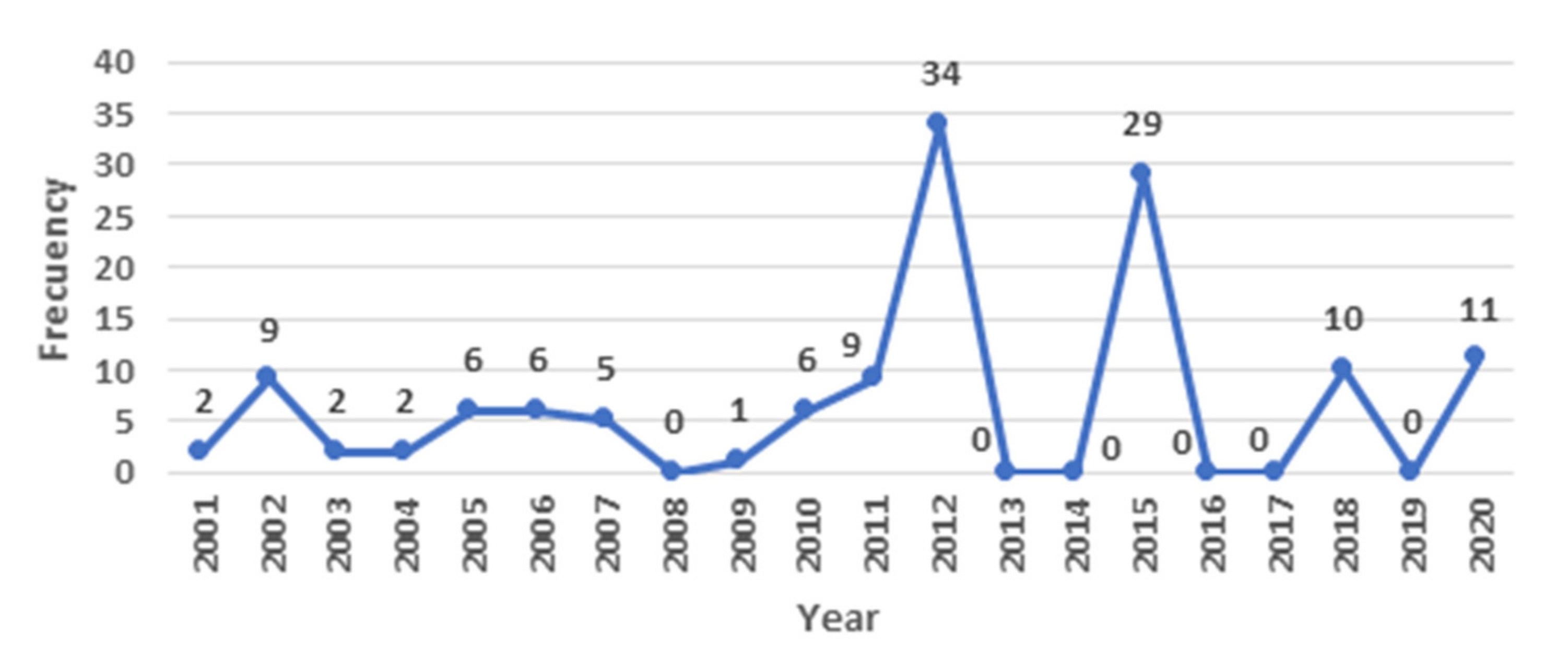


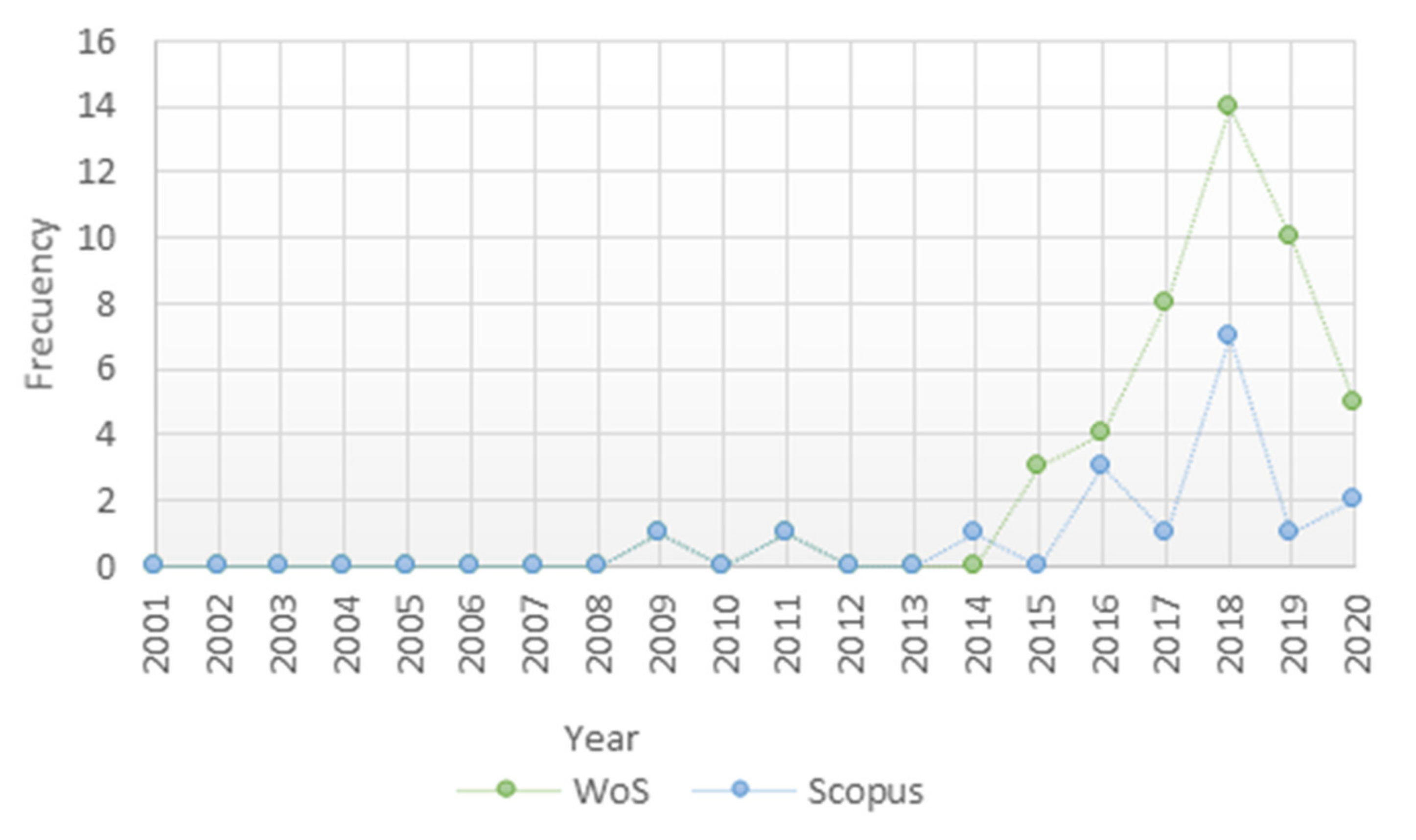

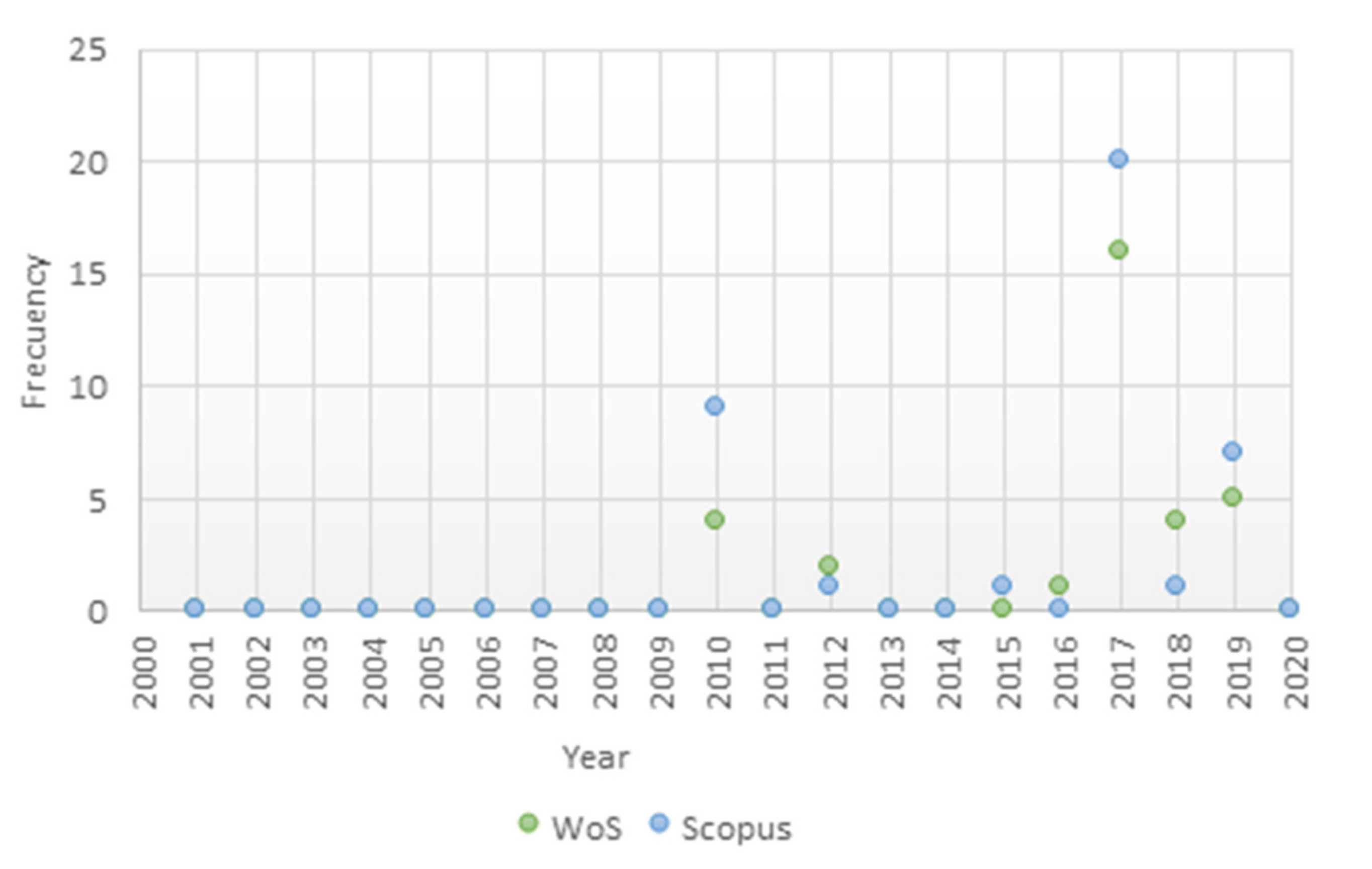
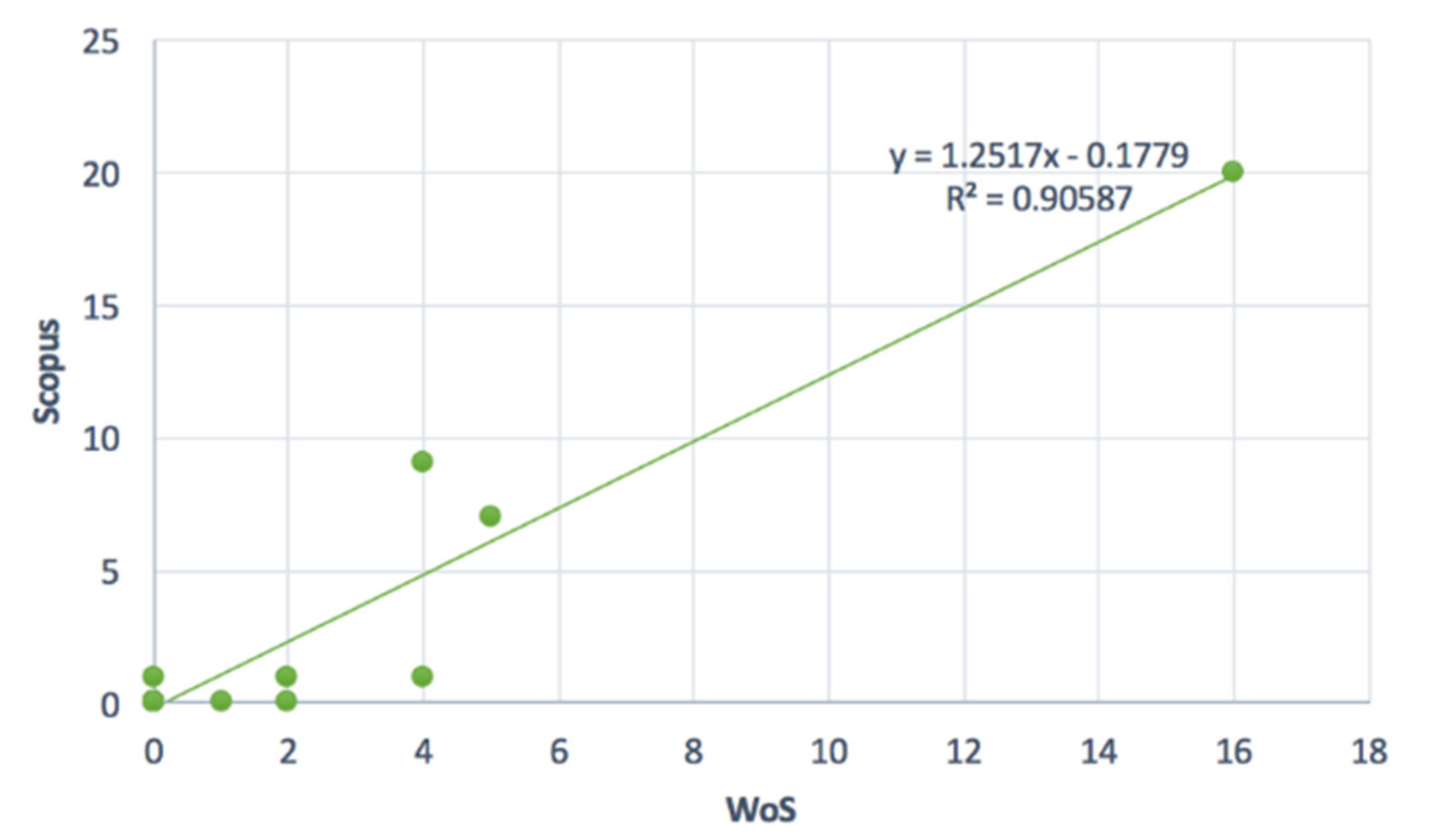

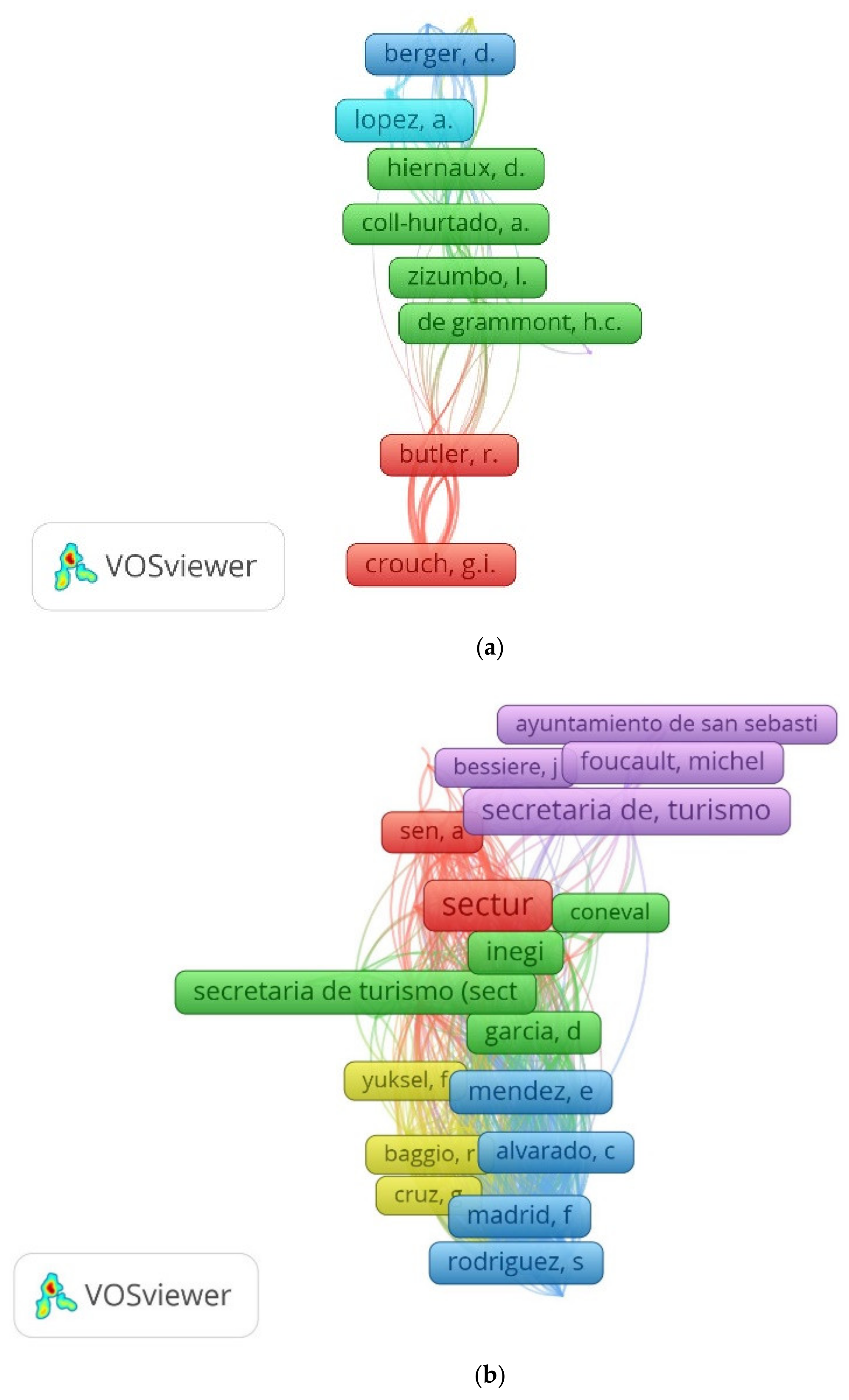
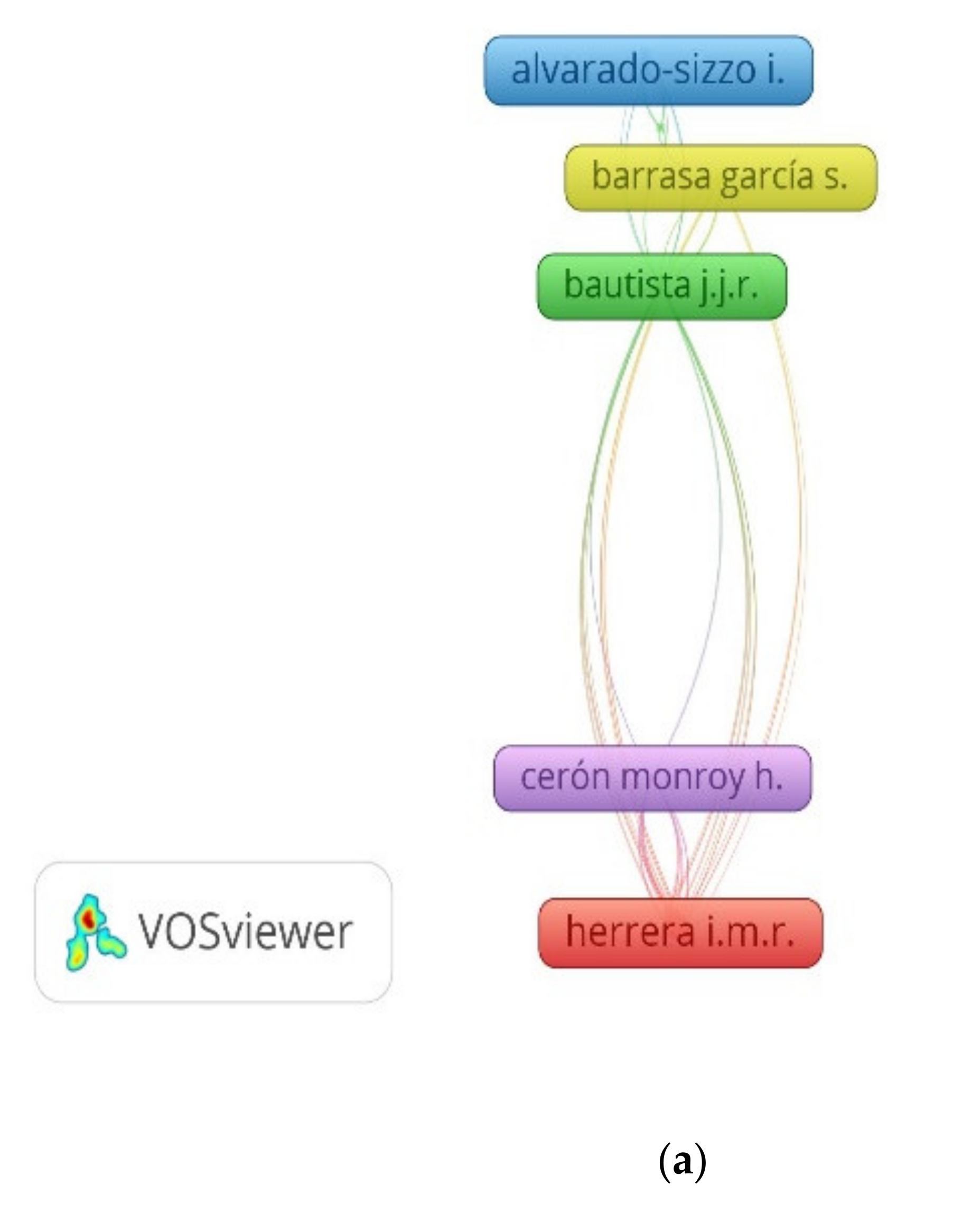
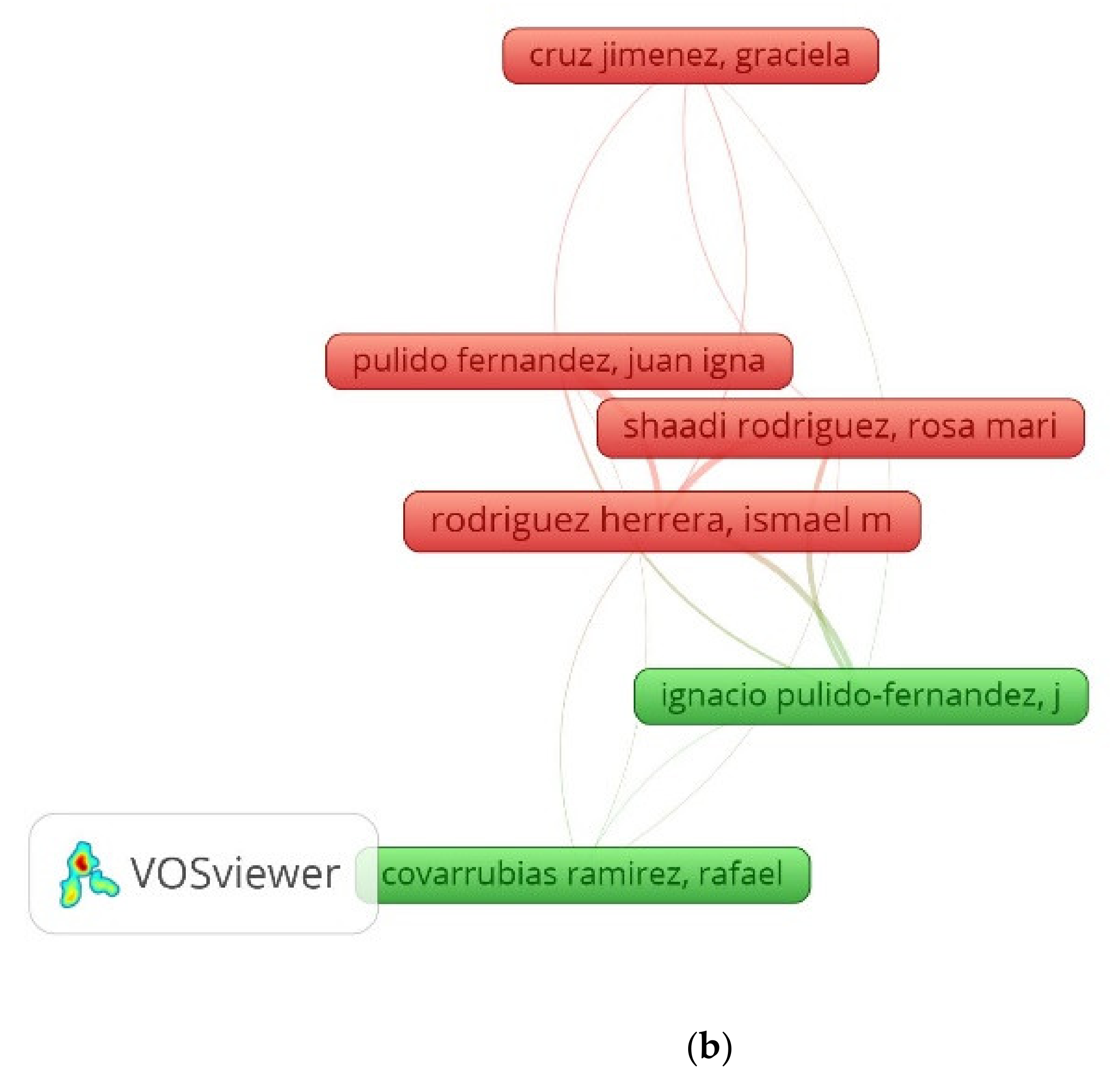
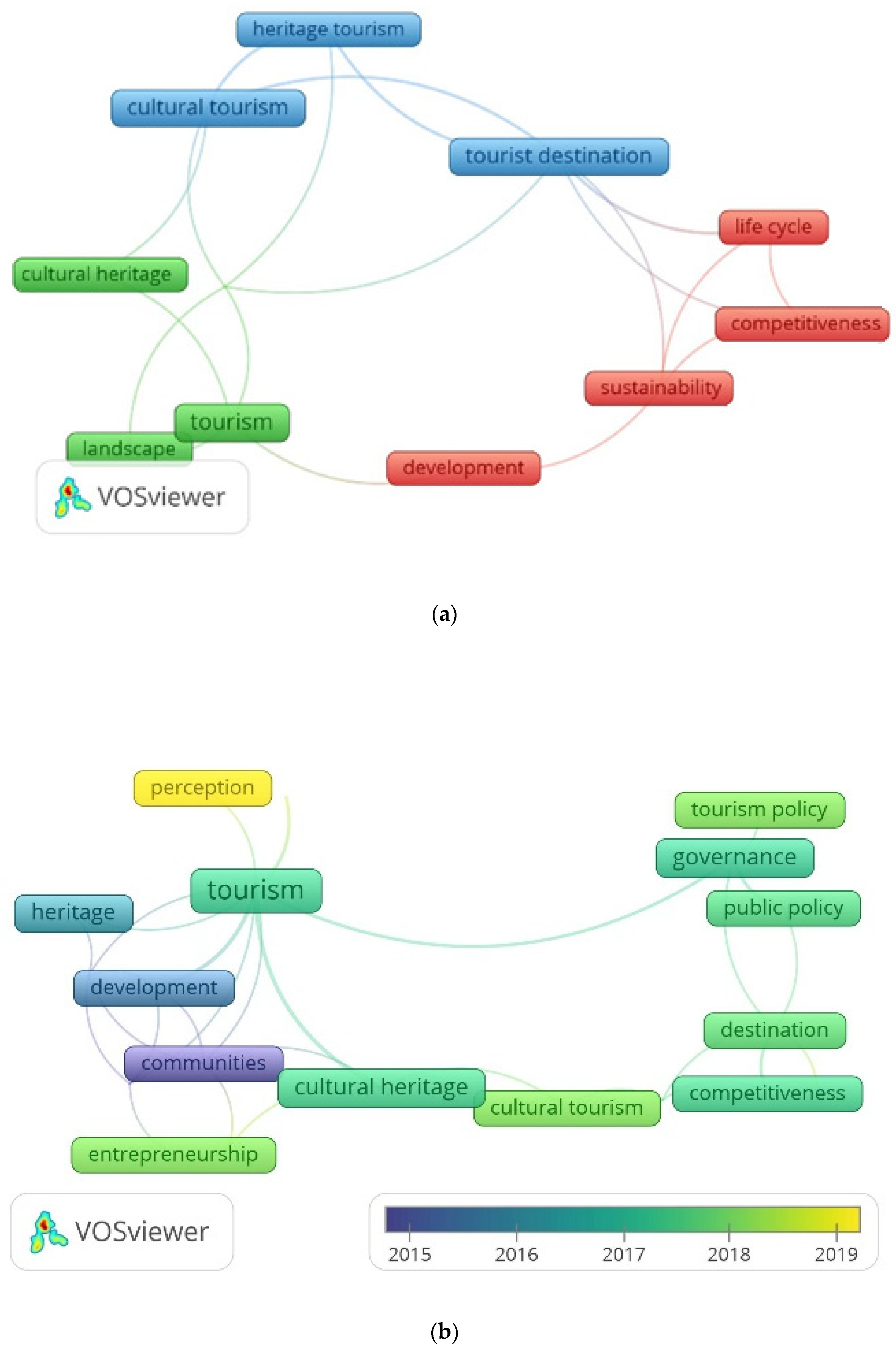
| Database | Equation |
|---|---|
| Scopus | (TITLE-ABS-KEY (magic * AND town *) OR TITLE-ABS-KEY (pueblo * AND mágico *)) AND (LIMIT-TO (PUBYEAR, 2001–2020)) AND (LIMIT-TO (DOCTYPE, “ar”)) |
| WoS | TOPIC (Magic * town *) OR TOPIC (Pueblo * Mágico *). Refined by: DOCUMENT TYPES (ARTICLE). Timespan: 2001 to 2020 |
| Database | Percentage of Singularity = (1 − Overlap) | Meyer’s Index = |
|---|---|---|
| WoS | 76.09% | 0.88 |
| Scopus | 35.29% | 0.68 |
| R | Article | Scopus | WoS | Main Results | ||
|---|---|---|---|---|---|---|
| C | C/Y | C | C/Y | |||
| 1 | Seizing community participation in sustainable development: Pueblos Mágicos of Mexico Clausen and Gyimothy [40] | 17 | 4.25 | 14 | 3.50 | They demonstrate how different groups bargain on behalf of the ‘community’ and how they seize the opportunity to promote different development priorities. In particular, they address the role of a North American migrant community in shaping sustainable tourism development as cultural brokers, social entrepreneurs and mediators of market knowledge. The paper criticizes the notion of homogenous local communities as an instrumental condition of sustainable and participatory development. |
| 2 | Tequila: magical center, traditional town. Heritage or privatization? Hernández [23] | 9 | 0.82 | 4 | 0.36 | Through the analytical readings of the cultural landscape of Tequila’s historical downtown, in Jalisco Mexico, we can notice the transformation of specific perimeters of a town similar to many others in Latin America, which gradually—and due to the economic and political intervention of both international organisms and the Mexican government—has turned from a rural area into an important tourist destination in Western Mexico and a referent in the construction of a new national identity, linked to successful commodities within the context of globalization. |
| 3 | Ecotourism as a path to sustainable development in an isolated Magic Town: The case study of La Trampa, Mexico Coronado, Rosas, Cerón [41] | 5 | 2.5 | - | - | The authors conclude that ecotourism is a possible alternative to highly marginalized localities within Magic Town municipalities and would be able to expand the benefits engendered by the program. Ecotourism can therefore represent a new option for tourists visiting marginalized communities in Mexico. |
| 4 | Territorial dynamics of cultural tourism in Izamal, Yucatan, Mexico Alvarado-Sizzo [22] | 3 | 0.75 | - | - | Tourist attractions in Izamal are associated with its history and culture. Despite the great potential of territorial resources for tourism, Izamal is contesting with other close destinations such as Merida, Valladolid, Chichen Itza and Cancun. The nearness to these sites leaves Izamal as a secondary destination limited to 1-day visits. Regarding the global context, the town can be considered an international destination visited by travelers coming from the five continents. |
| 5 | Sustainable tourism and social entrepreneurship. The magic town of Tequila, Mexico Manuel Saiz-Alvarez [42] | - | - | 3 | 1.50 | There are high levels of poverty in Tequila, although they are lower than in non-Agave locations. Excessive tequila protection prevents the development of other distilled beverages within the region. The production and marketing of tequila contributes to the sustainability of gastronomic tourism and nature in the tequila region and Tequila is a crucial piece in the Tourism Policy of Mexico by 2040, which guarantees its continuity and prevents the strengthening of tequila substitute beverages. |
| 6 | Community Development through the Empowerment of Indigenous Women in Cuetzalan Del Progreso, Mexico Duran-Diaz, Armenta-Ramirez, Kurjenoja, Schumacher [43] | - | - | 2 | 2.00 | Despite an inclusive legal and institutional framework, weak policy implementation and certain federal programs tend to segregate Indigenous communities. Mechanisms such as cultural tourism and inclusive land management programs, capacity building initiatives, and female associations have proven useful for empowering women and have had positive socioeconomic impacts on the community. This research concluded that female Indigenous associations are a tool to empower rural women, grant them tenure security, strengthen their engagement in decision making, and consolidate them as key stakeholders in community development. |
| 7 | Tourism, pottery and women’s work in the Magical Town of Metepec, Mexico Vizcaino-Suárez, Serrano-Barquín, Cruz-Jiménez, Pastor-Alfonso [44] | - | - | 2 | 0.67 | Even though the majority of artisans in Metepec are male, women have adopted essential tasks in pottery production and participate actively in the sale of crafts for the tourism market. Women’s work is not always visible or socially recognized due to the prevailing gender dynamics and the differences in power within the family and community contexts. This research contributes to the body of knowledge on tourism and gender in Mexico and aims to make women’s contributions visible in local tourism contexts. |
| 8 | Policy networks, elites and governance. A conceptual framework for a case study in tourism De la Rosa, Cruz, Castillo [45] | - | - | 2 | 0.50 | This paper contributes to the theoretical discussion related to the assumptions of public policy networks, the elite’s theory and governance. Together they support an empirical approach to a case study: the Magical Towns Program in Mexico. This dissertation challenges the argument that governance dynamics may be generated even under certain conditions (nepotism, corruption, favoring private interests) among actors linked to tourism and this federal program, which relate a policy network. |
| 9 | Divided over Tourism: Zapotec Responses to Mexico’s ‘Magical Villages Program’ Gross [46] | 1 | 0.11 | 2 | 0.22 | This article discusses local reactions to the Magical Villages Program and the villagers’ diverse perceptions of the impact of tourism on local culture and identity. These perceptions tend to be polarized and fall into two clearly distinguishable camps. Some villagers associate tourism with material gains and increased employment opportunities. Others, however, perceive it as a threat to communal intimacy and local ways of life, and accuse it of increasing inequality in the village. Such polarization of approaches reflects, at least partly, the pre-existing divisions and hierarchies in the village. Similarly, to some of the major anthropological approaches to the impact of tourism on host communities, especially in Latin America, the local discourse on tourism and tourists in Capulálpam centers on the notions of development and destruction. |
| R | Name | Affiliation | Country | TP | FA | TC | TC/TP | Crane |
|---|---|---|---|---|---|---|---|---|
| 1 | Pulido Fernandez, Juan Ignacio | Univ Jaen, Jaen, Spain | Spain | 4 | 0 | 2 | 0.50 | Aspirants/Intermediate |
| - | Rodriguez Herrera, Ismael Manuel | Autonomous Univ Aguascalientes, Ctr Econ & Adm Sci, Dept Tourism, Aguascalientes, Mexico | Mexico | 4 | 1 | 2 | 0.50 | |
| - | Shaadi Rodriguez, Rosa Maria Angelica | Autonomous Univ Aguascalientes, Ctr Econ & Adm Sci, Dept Tourism, Aguascalientes, Mexico | Mexico | 4 | 3 | 2 | 0.50 | |
| 2 | Cruz Jimenez, Graciela | Univ Autonoma Estado Mexico, Fac Turismo & Gastron, Ctr Invest & Estudios Turist, Mexico City, DF, Mexico. | Mexico | 3 | 0 | 4 | 1.33 | |
| 3 | Covarrubias Ramirez, Rafael | Univ Colima, Colima, Mexico | Mexico | 2 | 2 | 0 | 0.00 | |
| - | De la Rosa Flores, Beatriz Adriana | Univ Autonoma Estado Mexico, Ctr Invest & Estudios Turist, Toluca, Mexico | Mexico | 2 | 1 | 2 | 1.00 | |
| - | Alvarado-Sizzo, Ilia | Universidad Nacional Autónoma de México | Mexico | 2 | 1 | 3 | 1.50 |
| WoS | Scopus | ||||||
|---|---|---|---|---|---|---|---|
| NAA | NA | % | Names | NA | % | Names | Crane/Lotka |
| 1 | 81 | 93% | Other authors | 23 | 85% | Other authors | Transient authors |
| 2 | 2 | 2% | De la Rosa Flores, Beatriz Adriana; Covarrubias Ramírez, Rafael | 1 | 4% | Alvarado-Sizzo, Ilia | Aspirants/ Intermediate |
| 3 | 1 | 1% | Cruz Jiménez, Graciela | 3 | 11% | Shaadi Rodríguez, Rosa María Angélica; Rodríguez Herrera, Ismael Manuel; Pulido Fernández, Juan Ignacio | |
| 4 | 3 | 4% | Shaadi Rodríguez, Rosa María Angélica; Rodríguez Herrera, Ismael Manuel; Pulido Fernández, Juan Ignacio | - | - | - | |
| 87 | 100% | 27 | 100% | ||||
| Country | WoS | Scopus | ||||
| Authors | Authorship | Centers/ University | Authors | Authorship | Centers/ University | |
| Mexico | 73 | 83 | 28 | 14 | 28 | 14 |
| Spain | 6 | 9 | 5 | 5 | 4 | 2 |
| Slovakia | 1 | 1 | 1 | 1 | 1 | 1 |
| Denmark | 2 | 2 | 1 | 1 | 2 | 1 |
| France | 0 | 0 | 0 | 1 | 1 | 1 |
| Finland | 1 | 1 | 1 | 1 | 1 | 1 |
| Poland | 2 | 2 | 1 | 0 | 0 | 0 |
| Germany | 1 | 1 | 1 | 0 | 0 | 0 |
| Cuba | 1 | 1 | 1 | 0 | 0 | 0 |
| Ecuador | 1 | 1 | 1 | 0 | 0 | 0 |
| Bolivia | 1 | 1 | 1 | 0 | 0 | 0 |
| Portugal | 1 | 1 | 1 | 0 | 0 | 0 |
| Total | 90 | 103 | 42 | 23 | 37 | 20 |
| WoS | Scopus | |||||
|---|---|---|---|---|---|---|
| R | Institution | Country | A | As | A | As |
| 1 | Universidad de Guadalajara | México | 12 | 12 | ||
| 2 | Universidad Autonóma de Aguascalientes | México | 4 | 10 | 3 | 7 |
| Universidad Autonóma del Estado de México | México | 7 | 10 | |||
| 3 | Universidad Autónoma de Baja California Sur | México | 6 | 6 | ||
| 4 | Universidad Autónoma de Querétaro | México | 4 | 4 | ||
| Universidad Autónoma de Baja California | México | 3 | 4 | |||
| Universidad de Guanajuato | México | 4 | 4 | |||
| National Polytechnic Institute | México | 4 | 4 | |||
| Universidad Autónoma de Chapingo | México | 4 | 4 | |||
| Universidad de Jaen | España | 1 | 4 | 1 | 3 | |
| 5 | Universidad de las Americas de Puebla | México | 3 | 3 | ||
| Universidad de Colima | México | 2 | 3 | |||
| Colegio de Postgraduados | México | 3 | 3 | |||
| Universidad Autónoma de Occidente | México | 3 | 3 | |||
| 6 | Universidad de Sevilla | España | 2 | 2 | ||
| Universidad Autonóma Metropolitana | México | 2 | 2 | |||
| Universidad Autónoma del Estado de Morelos | México | 2 | 2 | |||
| Universidad Nacional Autónoma de México | México | 2 | 2 | 4 | 5 | |
| Universidad Autónoma de Sinaloa | México | 2 | 2 | |||
| Pedagogical University of Cracow | Polonia | 2 | 2 | |||
| Aalborg University | Dinamarca | 2 | 2 | 2 | 2 | |
| Anáhuac University | México | 2 | 2 | |||
| CONACYT | México | 2 | 2 | |||
| WoS | Scopus | |||||||
|---|---|---|---|---|---|---|---|---|
| Journal | f | hi% | Q | JCR | f | hi% | Q | SJR |
| Pasos-Revista de turismo y patrimonio cultural | 9 | 19.57% | - | ESCI | - | - | - | - |
| Investigaciones Turísticas | 3 | 6.52% | - | ESCI | 2 | 11.76% | 3 | 0.18 |
| Periplo sustentable | 3 | 6.52% | - | ESCI | - | - | - | - |
| Anuario turismo y sociedad | 2 | 4.35% | - | ESCI | - | - | - | - |
| Atelie geográfico | 2 | 4.35% | - | ESCI | - | - | - | - |
| Teoría y praxis | 2 | 4.35% | - | ESCI | - | - | - | - |
| Investigaciones geográficas | - | - | - | - | 2 | 5.88% | 3 | 0.24 |
| WoS | Scopus | |||||||
|---|---|---|---|---|---|---|---|---|
| Research Area | TP | %hi | TC | TC/TP | TP | %hi | TC | TC/TP |
| Social Sciences—Other topics | 24 | 48.97% | 26 | 1.1 | 15 | 50.00% | 22 | 1.5 |
| Geography | 4 | 8.16% | 1 | 0.3 | - | - | - | - |
| Environmental Sciences & Ecology | 3 | 6.12% | 16 | 5.3 | 1 | 3.33% | 17 | 17.0 |
| Urban Studies | 3 | 6.12% | 0 | 0.0 | - | - | - | - |
| Government & Law | 2 | 4.08% | 0 | 0.0 | - | - | - | - |
| History | 2 | 4.08% | 0 | 0.0 | - | - | - | - |
| Public Administration | 2 | 4.08% | 0 | 0.0 | - | - | - | - |
| Agriculture | 1 | 2.04% | 1 | 1.0 | - | - | - | - |
| Anthropology | 1 | 2.04% | 2 | 2.0 | - | - | - | - |
| Architecture | 1 | 2.04% | 0 | 0.0 | - | - | - | - |
| Art & Humanities—Other topics | 1 | 2.04% | 0 | 0.0 | 3 | 10.00% | 9 | 3.0 |
| Business & Economics | 1 | 2.04% | 3 | 3.0 | 6 | 20.00% | 26 | 4.3 |
| Demography | 1 | 2.04% | 0 | 0.0 | - | - | - | - |
| Engineering | 1 | 2.04% | 14 | 14.0 | 2 | 6.67% | 17 | 8.5 |
| Religion | 1 | 2.04% | 0 | 0.0 | - | - | - | - |
| Social Issues | 1 | 2.04% | 0 | 0.0 | - | - | - | - |
| Earth and Planetary Sciences | - | - | - | - | 2 | 6.67% | 0 | 0.0 |
| Energy | - | - | - | - | 1 | 3.33% | 17 | 17.0 |
| Total | 49 | 63 | 30 | 108 | ||||
| Ranking | Keywords | Frecuency WoS | Frecuency Scopus |
|---|---|---|---|
| 1 | Tourist destination | 14 | |
| 2 | Cultural tourism | 3 | 12 |
| 3 | Tourism | 16 | 9 |
| 4 | Heritage tourism | 8 | |
| 5 | Quintana Roo | 7 | |
| 6 | Competitiveness | 3 | 6 |
| 7 | Cultural heritage | 6 | 6 |
| 8 | Life cycle | 2 | 6 |
| 9 | Sustainability | 6 | |
| 10 | Development | 3 | 3 |
| 11 | Landscape | 3 | |
| 12 | Governance | 5 | |
| 13 | Communities | 2 | |
| 14 | Destination | 3 | |
| 15 | Identity | 2 | |
| 16 | Migration | 2 | |
| 17 | Image | 2 | |
| 18 | Local development | 2 | |
| 19 | Public policy | 2 | |
| 20 | Heritage | 4 | |
| 21 | Perception | 3 | |
| 22 | Sustainable development | 2 | |
| 23 | Tourism policy | 2 | |
| 24 | Entrepreneurship | 2 | |
| 25 | Other words with 0 or 1 repetitions | 142 | 87 |
| Cultural heritage, cultural resources, inherited resources, cultural tourism (13 articles) Hernández [23], Valenzuela [54], Morales & Pérez [55], García & Rivera [56], Pérez Solano & Del Carpio [57], Castillo et al. [58], Uhnak [59], García & Méndez [60], De la Rosa et al. [45], Alvarado-Sizzo [22], Rivero [61], Rosas [62], Sánchez et al. [63] |
| Pueblos Mágicos program as public policy (10 articles) De la Rosa et al. [64], Gross [46], Winiarczyk-Razniak & Razniak [65], Madrid [53], Cornejo-Ortega et al. [66], Cortes & Velez [67], Rodríguez et al. [68], Benavides Cortes [69], Vázquez [70], Paula & Carvalho [71] |
| Local development (7 articles) López [72], Nuñez & Ettinger [5], De León [73], Covarrubias & Rodríguez [74], Fernández [20], Gómez et al. [75], Flores [76] |
| Sustainable tourism, sustainable development, sustainable development (6 articles) Olmos-Martínez et al. [77], Clausen & Gyimothy [40], Rodriguez et al. [78], Muñoz [79], García et al. [80], Coronado et al. [41] |
| Entrepreneurship, social entrepreneurship (2 articles) Saiz-Alvarez [42], García [81] |
| Gender perspective, women’s empowerment (2 articles) Durán-Díaz et al. [43], Vizcaino-Suárez et al. [44] |
| Life cycle analysis (2 articles) Shaadi et al. [3], Shaadi et al. [7] |
| Quality of service, tourist satisfaction (2 articles) Miranda et al. [82], López [72] |
| Competitiveness, tourism competitiveness (2 articles) Hernández et al. [83], Shaadi et al. [84] |
Publisher’s Note: MDPI stays neutral with regard to jurisdictional claims in published maps and institutional affiliations. |
© 2021 by the authors. Licensee MDPI, Basel, Switzerland. This article is an open access article distributed under the terms and conditions of the Creative Commons Attribution (CC BY) license (https://creativecommons.org/licenses/by/4.0/).
Share and Cite
Flores-Romero, M.B.; Pérez-Romero, M.E.; Álvarez-García, J.; del Río-Rama, M.d.l.C. Bibliometric Mapping of Research on Magic Towns of Mexico. Land 2021, 10, 852. https://doi.org/10.3390/land10080852
Flores-Romero MB, Pérez-Romero ME, Álvarez-García J, del Río-Rama MdlC. Bibliometric Mapping of Research on Magic Towns of Mexico. Land. 2021; 10(8):852. https://doi.org/10.3390/land10080852
Chicago/Turabian StyleFlores-Romero, Martha B., Miriam E. Pérez-Romero, José Álvarez-García, and María de la Cruz del Río-Rama. 2021. "Bibliometric Mapping of Research on Magic Towns of Mexico" Land 10, no. 8: 852. https://doi.org/10.3390/land10080852
APA StyleFlores-Romero, M. B., Pérez-Romero, M. E., Álvarez-García, J., & del Río-Rama, M. d. l. C. (2021). Bibliometric Mapping of Research on Magic Towns of Mexico. Land, 10(8), 852. https://doi.org/10.3390/land10080852








